GWAS for Stripe Rust Resistance in Wild Emmer Wheat (Triticum dicoccoides) Population: Obstacles and Solutions
Abstract
:1. Introduction
2. Materials and Methods
2.1. Plant Material
2.2. Field Trials
2.3. Seedling Resistance Tests
2.4. Genotyping
2.5. Yr36 and Yr15 Presence Markers
2.6. Statistical Analysis
2.7. PCA
2.8. GWAS of Stripe Rust APR
2.9. GWAS for ASR
3. Results
3.1. Field Tests
3.2. Seedling Resistance Scoring
3.3. Genotyping
3.4. Population Structure
3.5. GWAS for ASR
3.6. GWAS for APR
4. Discussion
4.1. LD Levels
4.2. All-Stage Resistance
4.3. Adult Plant Resistance
4.4. The Effect of Diverse Genetic Background on Major Gene Resistance
4.5. Performance of GWAS Methods
5. Conclusions
Supplementary Materials
Author Contributions
Funding
Data Availability Statement
Acknowledgments
Conflicts of Interest
References
- Savary, S.; Willocquet, L.; Pethybridge, S.J.; Esker, P.; McRoberts, N.; Nelson, A. The global burden of pathogens and pests on major food crops. Nat. Ecol. Evol. 2019, 3, 430–439. [Google Scholar] [CrossRef] [PubMed]
- Chen, X. Pathogens which threaten food security: Puccinia striiformis, the wheat stripe rust pathogen. Food Secur. 2020, 12, 239–251. [Google Scholar] [CrossRef]
- Liu, T.; Wan, A.; Liu, D.; Chen, X. Changes of Races and Virulence Genes in Puccinia striiformis f. sp. tritici, the Wheat Stripe Rust Pathogen, in the United States from 1968 to 2009. Plant Dis. 2017, 101, 1522–1532. [Google Scholar] [CrossRef] [PubMed] [Green Version]
- Catalogue of Wheat Gene Symbols. Available online: https://shigen.nig.ac.jp/wheat/komugi/genes/symbolListPageAction.do?page=-1 (accessed on 18 November 2021).
- Wang, M.; Chen, X. Stripe Rust Resistance. In Stripe Rust; Springer: Berlin/Heidelberg, Germany, 2017; pp. 353–558. [Google Scholar]
- Jan, I.; Saripalli, G.; Kumar, K.; Kumar, A.; Singh, R.; Batra, R.; Sharma, P.K.; Balyan, H.S.; Gupta, P.K. Meta-QTLs and candidate genes for stripe rust resistance in wheat. Sci. Rep. 2021, 11, 22923. [Google Scholar] [CrossRef] [PubMed]
- Krattinger, S.G.; Lagudah, E.S.; Spielmeyer, W.; Singh, R.P.; Huerta-Espino, J.; McFadden, H.; Bossolini, E.; Selter, L.L.; Keller, B. A Putative ABC Transporter Confers Durable Resistance to Multiple Fungal Pathogens in Wheat. Science 2009, 323, 1360–1363. [Google Scholar] [CrossRef] [Green Version]
- Milne, R.J.; Dibley, K.E.; Schnippenkoetter, W.; Mascher, M.; Lui, A.C.; Wang, L.; Lo, C.; Ashton, A.R.; Ryan, P.R.; Lagudah, E.S. The Wheat Lr67 Gene from the Sugar Transport Protein 13 Family Confers Multipathogen Resistance in Barley. Plant Physiol. 2018, 179, 1285–1297. [Google Scholar] [CrossRef] [Green Version]
- Fu, D.; Uauy, C.; Distelfeld, A.; Blechl, A.; Epstein, L.; Chen, X.; Sela, H.; Fahima, T.; Dubcovsky, J. A Kinase-START Gene Confers Temperature-Dependent Resistance to Wheat Stripe Rust. Science 2009, 323, 1357–1360. [Google Scholar] [CrossRef] [Green Version]
- He, F.; Pasam, R.; Shi, F.; Kant, S.; Keeble-Gagnere, G.; Kay, P.; Forrest, K.; Fritz, A.; Hucl, P.; Wiebe, K.; et al. Exome Sequencing Highlights the Role of Wild-Relative Introgression in Shaping the Adaptive Landscape of the Wheat Genome. Nat. Genet. 2019, 51, 896–904. [Google Scholar] [CrossRef]
- Luo, M.-C.; Yang, Z.-L.; You, F.M.; Kawahara, T.; Waines, J.G.; Dvorak, J. The structure of wild and domesticated emmer wheat populations, gene flow between them, and the site of emmer domestication. Theor. Appl. Genet. 2007, 114, 947–959. [Google Scholar] [CrossRef]
- Nave, M.; Avni, R.; Çakır, E.; Portnoy, V.; Sela, H.; Pourkheirandish, M.; Ozkan, H.; Hale, I.; Komatsuda, T.; Dvorak, J.; et al. Wheat domestication in light of haplotype analyses of the Brittle rachis 1 genes (BTR1-A and BTR1-B). Plant Sci. 2019, 285, 193–199. [Google Scholar] [CrossRef]
- Özkan, H.; Willcox, G.; Graner, A.; Salamini, F.; Kilian, B. Geographic distribution and domestication of wild emmer wheat (Triticum dicoccoides). Genet. Resour. Crop Evol. 2010, 58, 11–53. [Google Scholar] [CrossRef]
- Feldman, M.; Kislev, M.E. Domestication of emmer wheat and evolution of free-threshing tetraploid wheat. Isr. J. Plant Sci. 2007, 55, 207–221. [Google Scholar] [CrossRef]
- Nevo, E.; Korol, A.B.; Beiles, A.; Fahima, T. Evolution of Wild Emmer and Wheat Improvement: Population Genetics, Genetic Resources, and Genome Organization of Wheat’s Progenitor, Triticum dicoccoides; Springer Science & Business Media: Berlin/Heidelberg, Germany, 2002; ISBN 978-3-540-41750-7. [Google Scholar]
- Aaronsohn, A. Agricultural and Botanical Explorations in Palestine; US Government Printing Office: Washington, DC, USA, 1910.
- Avni, R.; Nave, M.; Barad, O.; Baruch, K.; Twardziok, S.O.; Gundlach, H.; Hale, I.; Mascher, M.; Spannagl, M.; Wiebe, K.; et al. Wild emmer genome architecture and diversity elucidate wheat evolution and domestication. Science 2017, 357, 93–97. [Google Scholar] [CrossRef] [PubMed] [Green Version]
- The International Wheat Genome Sequencing Consortium (IWGSC); Appels, R.; Eversole, K.; Stein, N.; Feuillet, C.; Keller, B.; Rogers, J.; Pozniak, C.J.; Choulet, F.; Distelfeld, A.; et al. Shifting the limits in wheat research and breeding using a fully annotated reference genome. Science 2018, 361, 7191. [Google Scholar] [CrossRef] [Green Version]
- Maccaferri, M.; Harris, N.S.; Twardziok, S.O.; Pasam, R.K.; Gundlach, H.; Spannagl, M.; Ormanbekova, D.; Lux, T.; Prade, V.M.; Milner, S.G.; et al. Durum wheat genome highlights past domestication signatures and future improvement targets. Nat. Genet. 2019, 51, 885–895. [Google Scholar] [CrossRef] [Green Version]
- Klymiuk, V.; Yaniv, E.; Huang, L.; Raats, D.; Fatiukha, A.; Chen, S.; Feng, L.; Frenkel, Z.; Krugman, T.; Lidzbarsky, G.; et al. Cloning of the wheat Yr15 resistance gene sheds light on the plant tandem kinase-pseudokinase family. Nat. Commun. 2018, 9, 3735. [Google Scholar] [CrossRef] [Green Version]
- Marais, G.F.; Pretorius, Z.A.; Wellings, C.R.; McCallum, B.; Marais, A.S. Leaf rust and stripe rust resistance genes transferred to common wheat from Triticum dicoccoides. Euphytica 2005, 143, 115–123. [Google Scholar] [CrossRef]
- Zhang, H.; Zhang, L.; Wang, C.; Wang, Y.; Zhou, X.; Lv, S.; Liu, X.; Kang, Z.; Ji, W. Molecular mapping and marker development for the Triticum dicoccoides-derived stripe rust resistance gene YrSM139-1B in bread wheat cv. Shaanmai 139. Theor. Appl. Genet. 2015, 129, 369–376. [Google Scholar] [CrossRef]
- Elkot, A.F.; Singh, R.; Kaur, S.; Kaur, J.; Chhuneja, P. Mapping novel sources of leaf rust and stripe rust resistance introgressed from Triticum dicoccoides in cultivated tetraploid wheat background. J. Plant Biochem. Biotechnol. 2020, 30, 336–342. [Google Scholar] [CrossRef]
- Klymiuk, V.; Fatiukha, A.; Fahima, T. Wheat tandem kinases provide insights on disease-resistance gene flow and host–parasite co-evolution. Plant J. 2019, 98, 667–679. [Google Scholar] [CrossRef]
- Gou, J.-Y.; Li, K.; Wu, K.; Wang, X.; Lin, H.; Cantu, D.; Uauy, C.; Dobon-Alonso, A.; Midorikawa, T.; Inoue, K.; et al. Wheat Stripe Rust Resistance Protein WKS1 Reduces the Ability of the Thylakoid-Associated Ascorbate Peroxidase to Detoxify Reactive Oxygen Species. Plant Cell 2015, 27, 1755–1770. [Google Scholar] [CrossRef] [PubMed]
- Huang, L.; Sela, H.; Feng, L.; Chen, Q.; Krugman, T.; Yan, J.; Dubcovsky, J.; Fahima, T. Distribution and haplotype diversity of WKS resistance genes in wild emmer wheat natural populations. Theor. Appl. Genet. 2016, 129, 921–934. [Google Scholar] [CrossRef] [PubMed] [Green Version]
- Santure, A.W.; Garant, D. Wild GWAS—association mapping in natural populations. Mol. Ecol. Resour. 2018, 18, 729–738. [Google Scholar] [CrossRef] [PubMed]
- Sela, H.; Ezrati, S.; Ben-Yehuda, P.; Manisterski, J.; Akhunov, E.; Dvorak, J.; Breiman, A.; Korol, A. Linkage disequilibrium and association analysis of stripe rust resistance in wild emmer wheat (Triticum turgidum ssp. dicoccoides) population in Israel. Theor. Appl. Genet. 2014, 127, 2453–2463. [Google Scholar] [CrossRef]
- Long, L.; Yao, F.; Yu, C.; Ye, X.; Cheng, Y.; Wang, Y.; Wu, Y.; Li, J.; Wang, J.; Jiang, Q.; et al. Genome-Wide Association Study for Adult-Plant Resistance to Stripe Rust in Chinese Wheat Landraces (Triticum aestivum L.) From the Yellow and Huai River Valleys. Front. Plant Sci. 2019, 10, 596. [Google Scholar] [CrossRef]
- Yang, F.; Liu, J.; Guo, Y.; He, Z.; Rasheed, A.; Wu, L.; Cao, S.; Nan, H.; Xia, X. Genome-Wide Association Mapping of Adult-Plant Resistance to Stripe Rust in Common Wheat (Triticum aestivum). Plant Dis. 2020, 104, 2174–2180. [Google Scholar] [CrossRef]
- Juliana, P.; Singh, R.P.; Singh, P.; Poland, J.A.; Bergstrom, G.C.; Huerta-Espino, J.; Bhavani, S.; Crossa, J.; Sorrells, M.E. Genome-wide association mapping for resistance to leaf rust, stripe rust and tan spot in wheat reveals potential candidate genes. Theor. Appl. Genet. 2018, 131, 1405–1422. [Google Scholar] [CrossRef] [Green Version]
- Godoy, J.G.; Rynearson, S.; Chen, X.; Pumphrey, M. Genome-Wide Association Mapping of Loci for Resistance to Stripe Rust in North American Elite Spring Wheat Germplasm. Phytopathology 2018, 108, 234–245. [Google Scholar] [CrossRef] [Green Version]
- Cheng, B.; Gao, X.; Cao, N.; Ding, Y.; Gao, Y.; Chen, T.; Xin, Z.; Zhang, L. Genome-wide association analysis of stripe rust-resistance loci in wheat accessions from southwestern China. J. Appl. Genet. 2020, 61, 37–50. [Google Scholar] [CrossRef] [Green Version]
- Wang, J.; Zhang, Z. GAPIT Version 3: Boosting Power and Accuracy for Genomic Association and Prediction. bioRxiv 2020, 403170. [Google Scholar] [CrossRef]
- Zhang, Y.-W.; Tamba, C.L.; Wen, Y.-J.; Li, P.; Ren, W.-L.; Ni, Y.-L.; Gao, J.; Zhang, Y.-M. mrMLM v4.0.2: An R Platform for Multi-locus Genome-wide Association Studies. Genom. Proteom. Bioinform. 2020, 18, 481–487. [Google Scholar] [CrossRef] [PubMed]
- Baranwal, D.; Cu, S.; Stangoulis, J.; Trethowan, R.; Bariana, H.; Bansal, U. Identification of genomic regions conferring rust resistance and enhanced mineral accumulation in a HarvestPlus Association Mapping Panel of wheat. Theor. Appl. Genet. 2022, 1–18. [Google Scholar] [CrossRef] [PubMed]
- Tomar, V.; Dhillon, G.S.; Singh, D.; Singh, R.P.; Poland, J.; Chaudhary, A.A.; Bhati, P.K.; Joshi, A.K.; Kumar, U. Evaluations of Genomic Prediction and Identification of New Loci for Resistance to Stripe Rust Disease in Wheat (Triticum aestivum L.). Front. Genet. 2021, 12, 710485. [Google Scholar] [CrossRef] [PubMed]
- Liu, L.; Wang, M.; Zhang, Z.; See, D.R.; Chen, X. Identification of Stripe Rust Resistance Loci in U.S. Spring Wheat Cultivars and Breeding Lines Using Genome-Wide Association Mapping and Yr Gene Markers. Plant Dis. 2020, 104, 2181–2192. [Google Scholar] [CrossRef] [PubMed]
- Habib, M.; Awan, F.S.; Sadia, B.; Zia, M.A. Genome-Wide Association Mapping for Stripe Rust Resistance in Pakistani Spring Wheat Genotypes. Plants 2020, 9, 1056. [Google Scholar] [CrossRef]
- Gaurav, K.; Arora, S.; Silva, P.; Sánchez-Martín, J.; Horsnell, R.; Gao, L.; Brar, G.S.; Widrig, V.; Raupp, W.J.; Singh, N.; et al. Population genomic analysis of Aegilops tauschii identifies targets for bread wheat improvement. Nat. Biotechnol. 2021, 1–10. [Google Scholar] [CrossRef]
- Line, R.F.; Qayoum, A. Virulence, Aggressiveness, Evolution, and Distribution of Races of Puccinia striiformis (the Cause of Stripe Rust of Wheat) in North America, 1968-87; USDA-ARS: Washington, DC, USA, 1992.
- Wan, A.; Wang, X.; Kang, Z.; Chen, X. Variability of the Stripe Rust Pathogen. In Stripe Rust; Springer: Berlin/Heidelberg, Germany, 2017; pp. 35–154. [Google Scholar]
- Large, E.C. Growth Stages in Cereals Illustration of the Feekes Scale. Plant Pathol. 1954, 3, 128–129. [Google Scholar] [CrossRef]
- Huang, S.; Steffenson, B.; Sela, H.; Stinebaugh, K. Resistance of Aegilops longissima to the Rusts of Wheat. Plant Dis. 2018, 102, 1124–1135. [Google Scholar] [CrossRef] [Green Version]
- Chen, X. Epidemiology and control of stripe rust [Puccinia striiformis f. sp. tritici] on wheat. Can. J. Plant Pathol. 2005, 27, 314–337. [Google Scholar] [CrossRef]
- Cheng, J.; Yan, J.; Sela, H.; Manisterski, J.; Lewinsohn, D.; Nevo, E.; Fahima, T. Pathogen race determines the type of resistance response in the stripe rust—Triticum dicoccoides pathosystem. Physiol. Plant. 2010, 139, 269–279. [Google Scholar] [CrossRef]
- Poland, J.A.; Brown, P.J.; Sorrells, M.E.; Jannink, J.-L. Development of High-Density Genetic Maps for Barley and Wheat Using a Novel Two-Enzyme Genotyping-by-Sequencing Approach. PLoS ONE 2012, 7, e32253. [Google Scholar] [CrossRef] [Green Version]
- Saintenac, C.; Jiang, D.; Wang, S.; Akhunov, E. Sequence-Based Mapping of the Polyploid Wheat Genome. G3 Genes Genomes Genet. 2013, 3, 1105–1114. [Google Scholar] [CrossRef] [PubMed] [Green Version]
- Glaubitz, J.C.; Casstevens, T.M.; Lu, F.; Harriman, J.; Elshire, R.J.; Sun, Q.; Buckler, E.S. TASSEL-GBS: A High Capacity Genotyping by Sequencing Analysis Pipeline. PLoS ONE 2014, 9, e90346. [Google Scholar] [CrossRef] [PubMed]
- Browning, B.L.; Zhou, Y.; Browning, S.R. A One-Penny Imputed Genome from Next-Generation Reference Panels. Am. J. Hum. Genet. 2018, 103, 338–348. [Google Scholar] [CrossRef] [Green Version]
- Dowle, M.; Srinivasan, A.; Short, T.; Lianoglou, S. Data. Table: Extension of ‘Data.Frame’. Available online: https://cran.r-project.org/web/packages/data.table/index.html (accessed on 25 February 2019).
- Frutos, E.; Galindo, M.P.; Leiva, V. An interactive biplot implementation in R for modeling genotype-by-environment interaction. Stoch. Environ. Res. Risk Assess. 2014, 28, 1629–1641. [Google Scholar] [CrossRef]
- Endelman, J.B. Ridge Regression and Other Kernels for Genomic Selection with R Package rrBLUP. Plant Genome 2011, 4, 250–255. [Google Scholar] [CrossRef] [Green Version]
- Kruijer, W.; Boer, M.P.; Malosetti, M.; Flood, P.J.; Engel, B.; Kooke, R.; Keurentjes, J.J.; van Eeuwijk, F.A. Marker-based estimation of heritability in immortal populations. Genetics 2015, 199, 379–398. [Google Scholar] [CrossRef]
- Stacklies, W.; Redestig, H.; Scholz, M.; Walther, D.; Selbig, J. pcaMethods a bioconductor package providing PCA methods for incomplete data. Bioinformatics 2007, 23, 1164–1167. [Google Scholar] [CrossRef]
- Jombart, T. adegenet: A R package for the multivariate analysis of genetic markers. Bioinformatics 2008, 24, 1403–1405. [Google Scholar] [CrossRef] [Green Version]
- Jombart, T.; Devillard, S.; Dufour, A.-B.; Pontier, D. Revealing cryptic spatial patterns in genetic variability by a new multivariate method. Heredity 2008, 101, 92–103. [Google Scholar] [CrossRef] [Green Version]
- Therneau, T.M. Coxme: Mixed Effects Cox Models. Available online: https://cran.r-project.org/web/packages/coxme/index.html (accessed on 3 August 2020).
- Bartoń, K. MuMIn: Multi-Model Inference. Available online: https://cran.r-project.org/web/packages/MuMIn/index.html (accessed on 4 May 2020).
- Akaike, H. Information theory and an extension of the maximum likelihood principle. In Selected papers of Hirotugu Akaike; Springer: New York, NY, USA, 1998; pp. 199–213. [Google Scholar]
- Benjamini, Y.; Hochberg, Y. Controlling the False Discovery Rate: A Practical and Powerful Approach to Multiple Testing. J. R. Stat. Soc. Ser. B Methodol. 1995, 57, 289–300. [Google Scholar] [CrossRef]
- Basnet, B.R.; Ibrahim, A.M.H.; Chen, X.; Singh, R.P.; Mason, E.R.; Bowden, R.L.; Liu, S.; Hays, D.B.; Devkota, R.N.; Subramanian, N.K.; et al. Molecular Mapping of Stripe Rust Resistance in Hard Red Winter Wheat TAM 111 Adapted to the U.S. High Plains. Crop Sci. 2014, 54, 1361–1373. [Google Scholar] [CrossRef]
- Suenaga, K.; Singh, R.P.; Huerta-Espino, J.; William, H.M. Microsatellite Markers for Genes Lr34/Yr18 and Other Quantitative Trait Loci for Leaf Rust and Stripe Rust Resistance in Bread Wheat. Phytopathology 2003, 93, 881–890. [Google Scholar] [CrossRef] [PubMed] [Green Version]
- Bulli, P.; Zhang, J.; Chao, S.; Chen, X.; Pumphrey, M. Genetic Architecture of Resistance to Stripe Rust in a Global Winter Wheat Germplasm Collection. G3 Genes Genomes Genet. 2016, 6, 2237–2253. [Google Scholar] [CrossRef] [Green Version]
- Singh, R.; William, H.; Huerta-Espino, J.; Crosby, M. Identification and Mapping of Gene Yr31 for Resistance to Stripe Rust in Triticum Aestivum Cultivar Pastor. In Proceedings of the 10th International Wheat Genetics Symposium, Paestum, Italy, 1–6 September 2003; Pogna, N.E., Romana, M., Pogna, E.A., Galterio, G., Eds.; Instituto Sperimentale per la Cerealicoltura: Rome, Italy, 2003; pp. 411–413. [Google Scholar]
- Hou, L.; Ma, D.-F.; Hu, M.-L.; He, M.-M.; Lu, Y.; Jing, J.-X. Genetic Analysis and Molecular Mapping of an All-Stage Stripe Rust Resistance Gene in Triticum aestivum-Haynaldia villosa Translocation Line V3. J. Integr. Agric. 2013, 12, 2197–2208. [Google Scholar] [CrossRef]
- Jimmy, J.L.; Babu, S. Role of OsWRKY transcription factors in rice disease resistance. Trop. Plant Pathol. 2015, 40, 355–361. [Google Scholar] [CrossRef]
- Shindo, T.; Van Der Hoorn, R.A.L. Papain-like cysteine proteases: Key players at molecular battlefields employed by both plants and their invaders. Mol. Plant Pathol. 2007, 9, 119–125. [Google Scholar] [CrossRef]
- Christopher, M.D.; Liu, S.; Hall, M.D.; Marshall, D.S.; Fountain, M.O.; Johnson, J.W.; Milus, E.A.; Garland-Campbell, K.A.; Chen, X.; Griffey, C.A. Identification and Mapping of Adult Plant Stripe Rust Resistance in Soft Red Winter Wheat VA00W-38. Crop Sci. 2013, 53, 871–879. [Google Scholar] [CrossRef]
- Erayman, M.; Turktas, M.; Akdogan, G.; Gurkok, T.; Inal, B.; Ishakoglu, E.; Ilhan, E.; Unver, T. Transcriptome analysis of wheat inoculated with Fusarium graminearum. Front. Plant Sci. 2015, 6, 867. [Google Scholar] [CrossRef] [Green Version]
- Figueiredo, L.; Santos, R.; Figueiredo, A. Defense and Offense Strategies: The Role of Aspartic Proteases in Plant–Pathogen Interactions. Biology 2021, 10, 75. [Google Scholar] [CrossRef]
- Basnet, B.R.; Singh, R.P.; Ibrahim, A.M.H.; Herrera-Foessel, S.A.; Huerta-Espino, J.; Lan, C.; Rudd, J.C. Characterization of Yr54 and other genes associated with adult plant resistance to yellow rust and leaf rust in common wheat Quaiu 3. Mol. Breed. 2013, 33, 385–399. [Google Scholar] [CrossRef]
- Zhou, X.L.; Zhang, Y.; Zeng, Q.D.; Chen, X.M.; Han, D.J.; Huang, L.L.; Kang, Z.S. Identification of QTL for adult plant resistance to stripe rust in Chinese wheat landrace Caoxuan 5. Euphytica 2015, 204, 627–634. [Google Scholar] [CrossRef]
- Lan, C.; Rosewarne, G.M.; Singh, R.P.; Herrera-Foessel, S.A.; Huerta-Espino, J.; Basnet, B.R.; Zhang, Y.; Yang, E. QTL characterization of resistance to leaf rust and stripe rust in the spring wheat line Francolin#1. Mol. Breed. 2014, 34, 789–803. [Google Scholar] [CrossRef]
- Case, A.J.; Naruoka, Y.; Chen, X.; Garland-Campbell, K.; Zemetra, R.S.; Carter, A.H. Mapping Stripe Rust Resistance in a BrundageXCoda Winter Wheat Recombinant Inbred Line Population. PLoS ONE 2014, 9, e91758. [Google Scholar] [CrossRef] [Green Version]
- Kumar, D. Salicylic acid signaling in disease resistance. Plant Sci. 2014, 228, 127–134. [Google Scholar] [CrossRef] [PubMed]
- Yang, E.; Li, G.; Li, L.; Zhang, Z.; Yang, W.; Peng, Y.; Zhu, Y.; Yang, Z.; Rosewarne, G.M. Characterization of Stripe Rust Resistance Genes in the Wheat Cultivar Chuanmai45. Int. J. Mol. Sci. 2016, 17, 601. [Google Scholar] [CrossRef] [Green Version]
- Pelgrom, A.J.E.; Meisrimler, C.-N.; Elberse, J.; Koorman, T.; Boxem, M.; van den Ackerveken, G. Host Targets of Effectors of the Lettuce Downy Mildew Bremia Lactucae from CDNA-Based Yeast Two-Hybrid Screening. PLoS ONE 2020, 15, e0226540. [Google Scholar] [CrossRef]
- Lu, Y.; Wang, M.; Chen, X.; See, D.; Chao, S.; Jing, J. Mapping of Yr62 and a small-effect QTL for high-temperature adult-plant resistance to stripe rust in spring wheat PI 192252. Theor. Appl. Genet. 2014, 127, 1449–1459. [Google Scholar] [CrossRef]
- Chen, Y.; Li, Y.; Ren, H.; Zhou, J.; Wang, L.; Yang, Y.; Hao, X.; Wang, X. Genome-wide identification and expression profiling reveal the diverse role of Methyl-CpG-binding domain proteins in tea plant Camellia sinensis. Beverage Plant Res. 2021, 1, 10. [Google Scholar] [CrossRef]
- Feng, J.; Zuo, L.L.; Zhang, Z.Y.; Lin, R.M.; Cao, Y.Y.; Xu, S.C. Quantitative trait loci for temperature-sensitive resistance to Puccinia striiformis f. sp. tritici in wheat cultivar Flinor. Euphytica 2010, 178, 321–329. [Google Scholar] [CrossRef]
- Lu, Y.; Lan, C.; Liang, S.; Zhou, X.; Liu, D.; Zhou, G.; Lu, Q.; Jing, J.; Wang, M.; Xia, X.; et al. QTL mapping for adult-plant resistance to stripe rust in Italian common wheat cultivars Libellula and Strampelli. Theor. Appl. Genet. 2009, 119, 1349–1359. [Google Scholar] [CrossRef] [PubMed]
- Mallard, S.; Gaudet, D.; Aldeia, A.; Abelard, C.; Besnard, A.L.; Sourdille, P.; Dedryver, F. Genetic analysis of durable resistance to yellow rust in bread wheat. Theor. Appl. Genet. 2005, 110, 1401–1409. [Google Scholar] [CrossRef] [PubMed]
- Yuan, X.; Wang, H.; Cai, J.; Li, D.; Song, F. NAC transcription factors in plant immunity. Phytopathol. Res. 2019, 1, 3. [Google Scholar] [CrossRef]
- Santra, D.K.; Chen, X.M.; Santra, M.; Campbell, K.G.; Kidwell, K.K. Identification and mapping QTL for high-temperature adult-plant resistance to stripe rust in winter wheat (Triticum aestivum L.) cultivar ‘Stephens’. Theor. Appl. Genet. 2008, 117, 793–802. [Google Scholar] [CrossRef]
- Bariana, H.S.; Bansal, U.; Schmidt, A.; Lehmensiek, A.; Kaur, J.; Miah, H.; Howes, N.; McIntyre, C. Molecular mapping of adult plant stripe rust resistance in wheat and identification of pyramided QTL genotypes. Euphytica 2010, 176, 251–260. [Google Scholar] [CrossRef]
- Steele, J.F.C.; Hughes, R.K.; Banfield, M.J. Structural and biochemical studies of an NB-ARC domain from a plant NLR immune receptor. PLoS ONE 2019, 14, e0221226. [Google Scholar] [CrossRef] [PubMed] [Green Version]
- Zhao, X.-Y.; Qi, C.-H.; Jiang, H.; Zheng, P.-F.; Zhong, M.-S.; Zhao, Q.; You, C.-X.; Li, Y.-Y.; Hao, Y.-J. Functional identification of apple on MdHIR4 in biotic stress. Plant Sci. 2019, 283, 396–406. [Google Scholar] [CrossRef] [PubMed]
- Liu, J.; He, Z.; Wu, L.; Bai, B.; Wen, W.; Xie, C.; Xia, X. Genome-Wide Linkage Mapping of QTL for Adult-Plant Resistance to Stripe Rust in a Chinese Wheat Population Linmai x Zhong 892. PloS ONE 2015, 10, e0145462. [Google Scholar] [CrossRef] [Green Version]
- Liu, X.; Song, L.; Zhang, H.; Lin, Y.; Shen, X.; Guo, J.; Su, M.; Shi, G.; Wang, Z.; Lu, G. Rice ubiquitin-conjugating enzyme OsUBC26 is essential for immunity to the blast fungus Magnaporthe oryzae. Mol. Plant Pathol. 2021, 22, 1613–1623. [Google Scholar] [CrossRef]
- Douchkov, D.; Lueck, S.; Hensel, G.; Kumlehn, J.; Rajaraman, J.; Johrde, A.; Doblin, M.S.; Beahan, C.T.; Kopischke, M.; Fuchs, R.; et al. The barley (Hordeum vulgare) cellulose synthase-like D2 gene (HvCslD2) mediates penetration resistance to host-adapted and nonhost isolates of the powdery mildew fungus. New Phytol. 2016, 212, 421–433. [Google Scholar] [CrossRef] [Green Version]
- Sela, H.; Loutre, C.; Keller, B.; Schulman, A.; Nevo, E.; Korol, A.; Fahima, T. Rapid linkage disequilibrium decay in the Lr10 gene in wild emmer wheat (Triticum dicoccoides) populations. Theor. Appl. Genet. 2010, 122, 175–187. [Google Scholar] [CrossRef] [PubMed] [Green Version]
- Morrell, P.; Toleno, D.M.; Lundy, K.E.; Clegg, M.T. Low levels of linkage disequilibrium in wild barley (Hordeum vulgare ssp. spontaneum) despite high rates of self-fertilization. Proc. Natl. Acad. Sci. USA 2005, 102, 2442–2447. [Google Scholar] [CrossRef] [PubMed] [Green Version]
- Nordborg, M.; Borevitz, J.; Bergelson, J.; Berry, C.C.; Chory, J.; Hagenblad, J.; Kreitman, M.; Maloof, J.; Noyes, T.; Oefner, P.J.; et al. The extent of linkage disequilibrium in Arabidopsis thaliana. Nat. Genet. 2002, 30, 190–193. [Google Scholar] [CrossRef]
- Chao, S.; Dubcovsky, J.; Dvorak, J.; Luo, M.-C.; Baenziger, S.P.; Matnyazov, R.; Clark, D.R.; Talbert, L.E.; Anderson, J.A.; Dreisigacker, S.; et al. Population- and genome-specific patterns of linkage disequilibrium and SNP variation in spring and winter wheat (Triticum aestivum L.). BMC Genom. 2010, 11, 727. [Google Scholar] [CrossRef] [PubMed] [Green Version]
- GRIN-Global. Available online: https://npgsweb.ars-grin.gov/gringlobal/search (accessed on 8 December 2021).
- GRIS. Available online: http://www.wheatpedigree.net/ (accessed on 8 December 2021).
- Xiang, C.; Feng, J.Y.; Wang, M.N.; Chen, X.M.; See, D.R.; Wan, A.M.; Wang, T. Molecular Mapping of Stripe Rust Resistance Gene Yr76 in Winter Club Wheat Cultivar Tyee. Phytopathology 2016, 106, 1186–1193. [Google Scholar] [CrossRef] [PubMed] [Green Version]
- Lillemo, M.; Asalf, B.; Singh, R.; Huerta-Espino, J.; Chen, X.; He, Z.; Bjørnstad, Å. The Adult Plant Rust Resistance Loci Lr34/Yr18 and Lr46/Yr29 Are Important Determinants of Partial Resistance to Powdery Mildew in Bread Wheat Line Saar. Theor. Appl. Genet. 2008, 116, 1155–1166. [Google Scholar] [CrossRef] [PubMed]
- Dmochowska-Boguta, M.; Kloc, Y.; Zielezinski, A.; Werecki, P.; Nadolska-Orczyk, A.; Karlowski, W.M.; Orczyk, W. TaWAK6 encoding wall-associated kinase is involved in wheat resistance to leaf rust similar to adult plant resistance. PLoS ONE 2020, 15, e0227713. [Google Scholar] [CrossRef] [Green Version]
- Ensembl Genomes Triticum_dicoccoides. Available online: http://plants.ensembl.org/Triticum_dicoccoides/Info/Index (accessed on 8 December 2021).

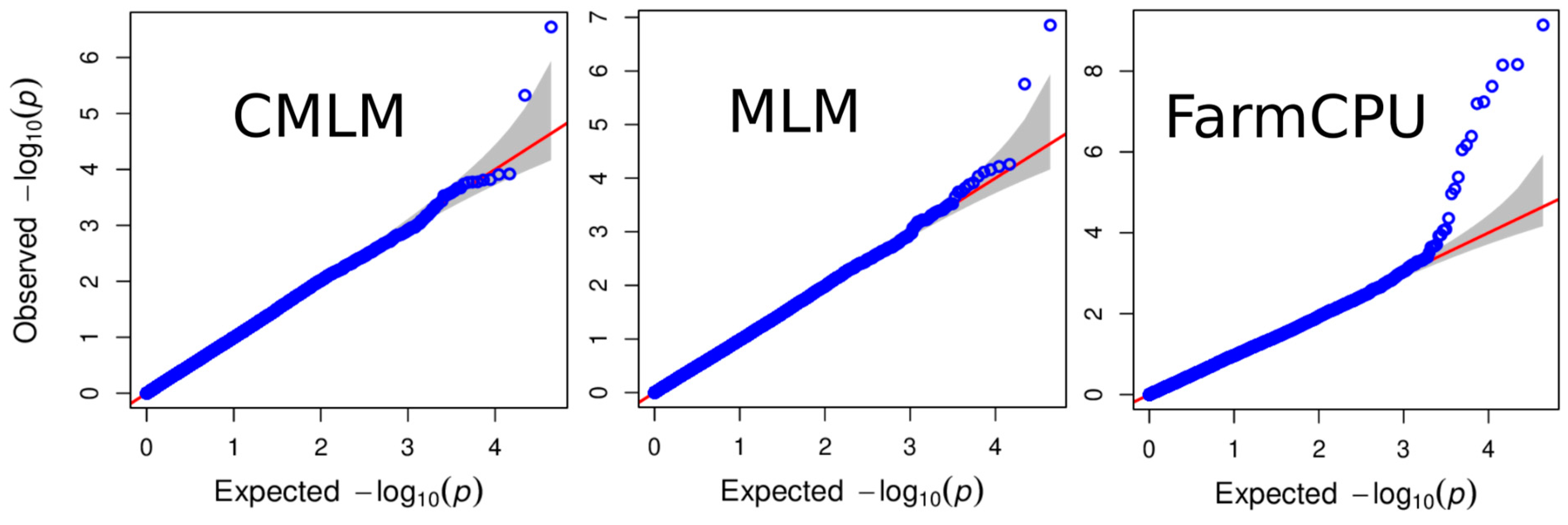
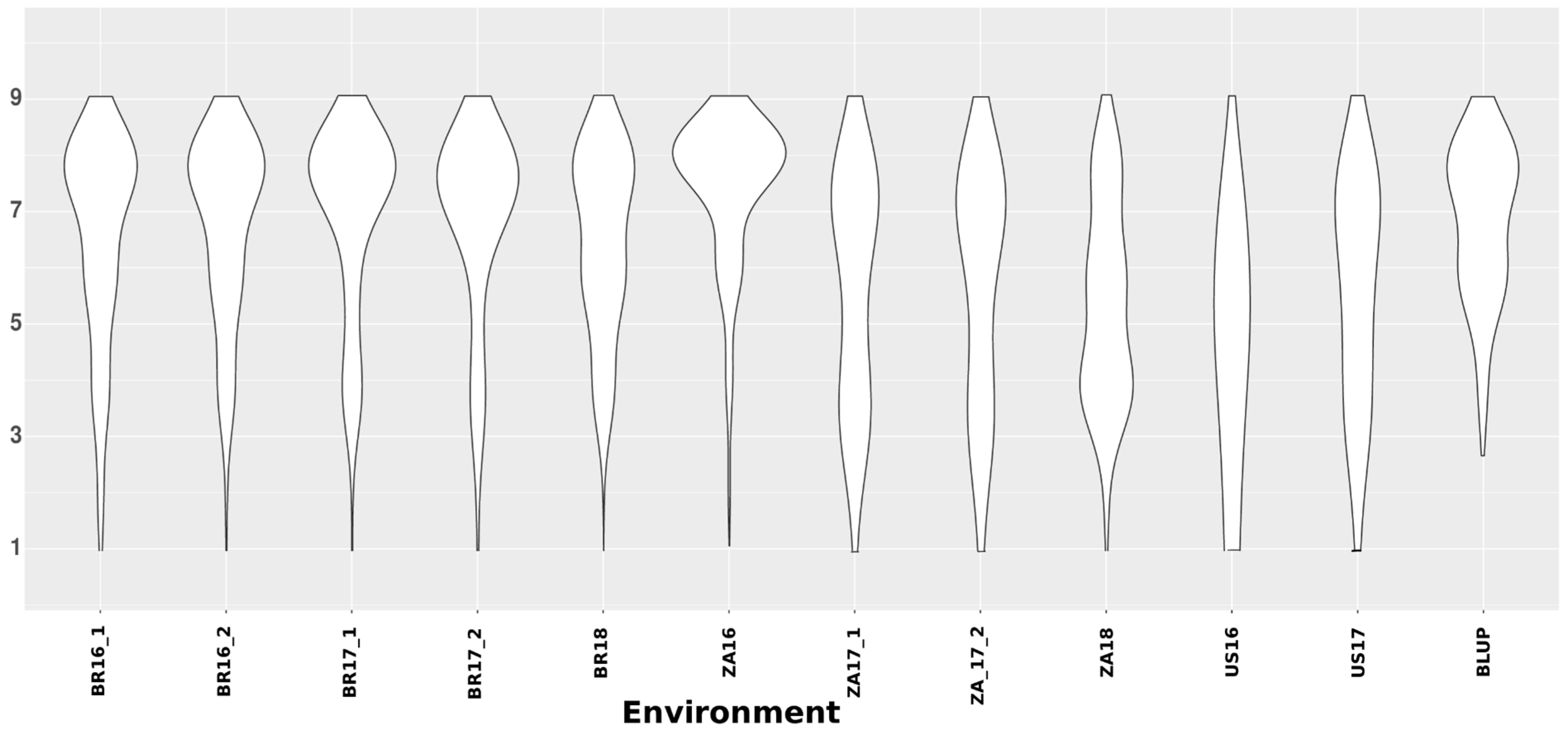
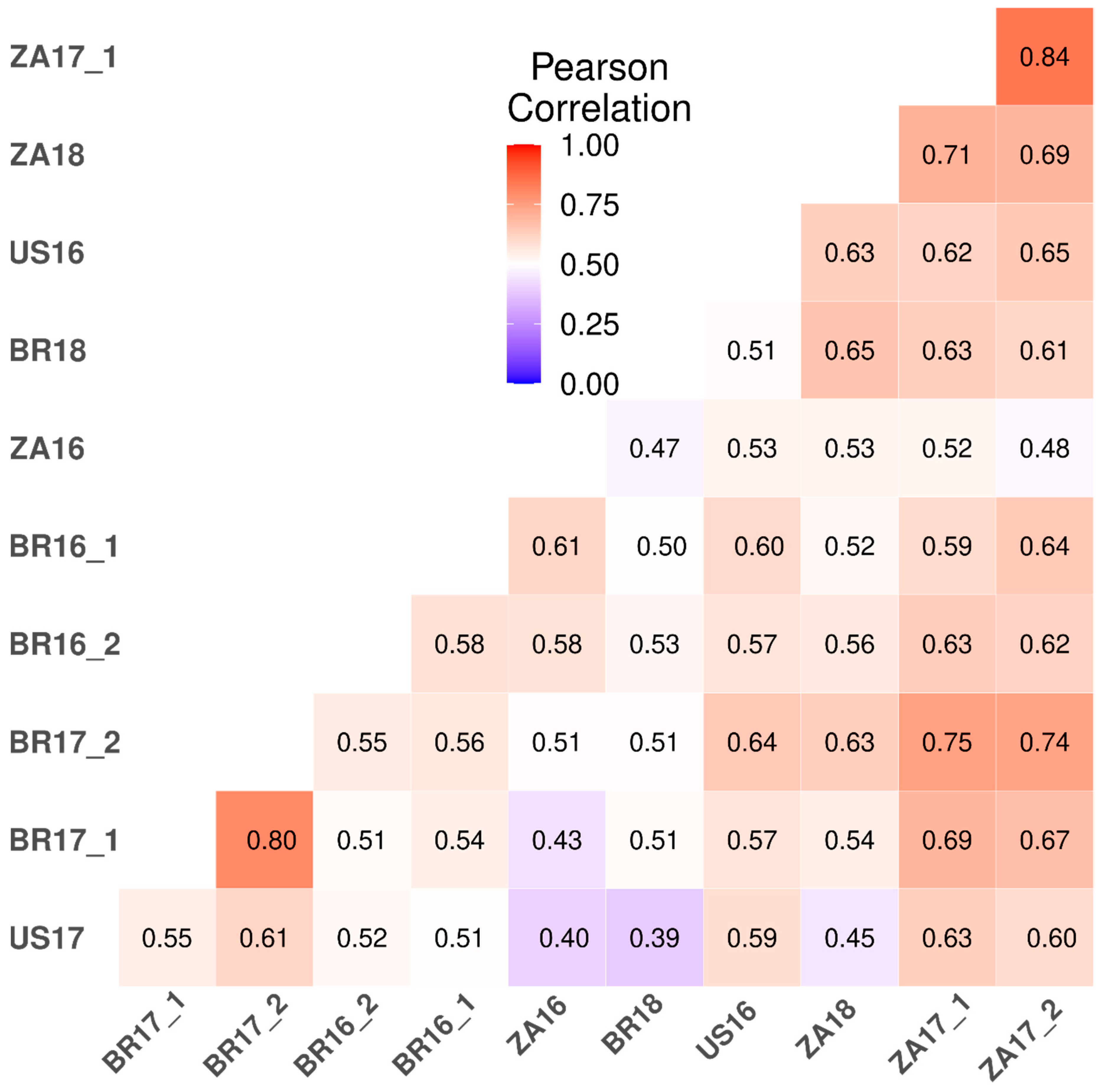
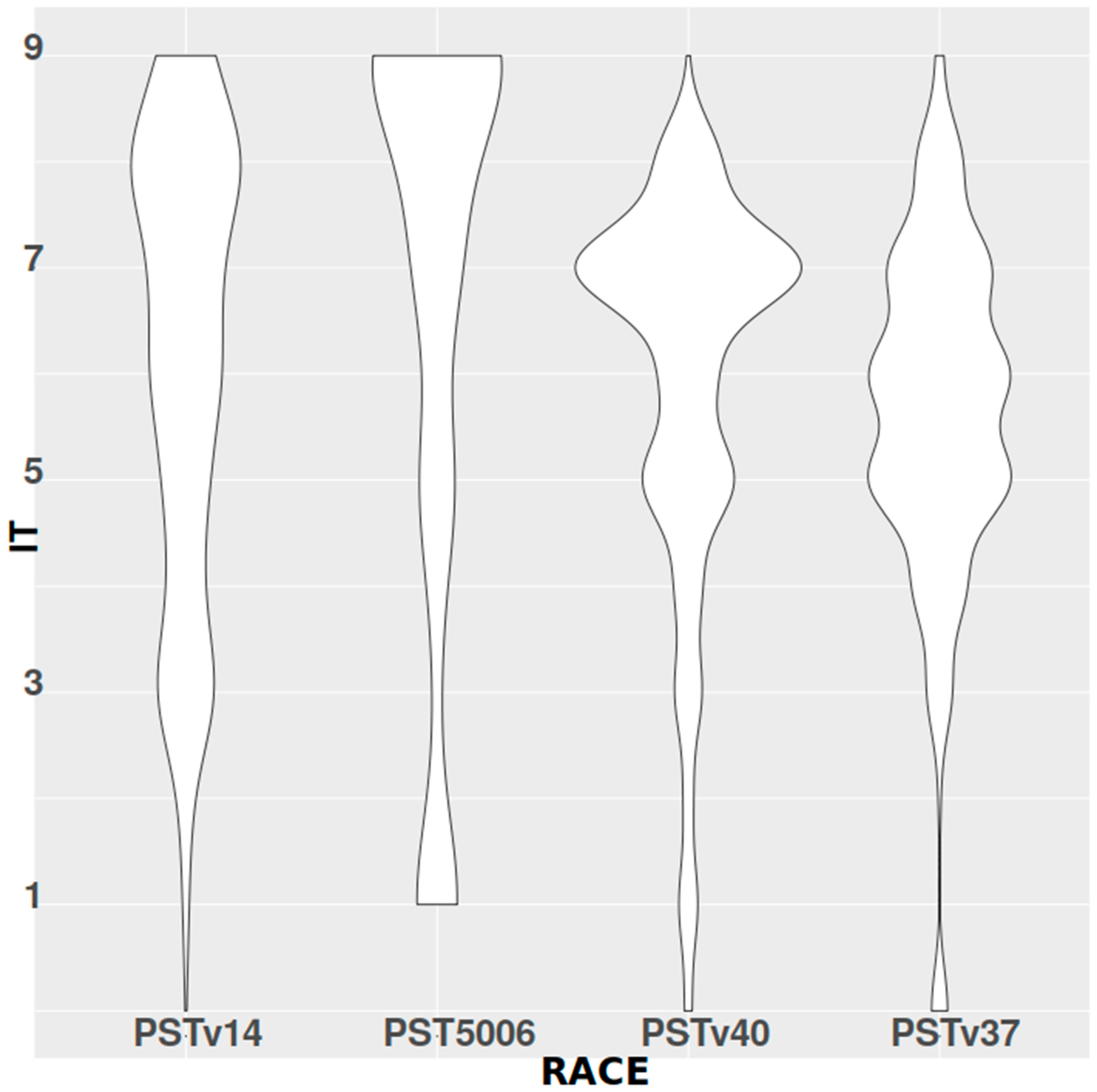
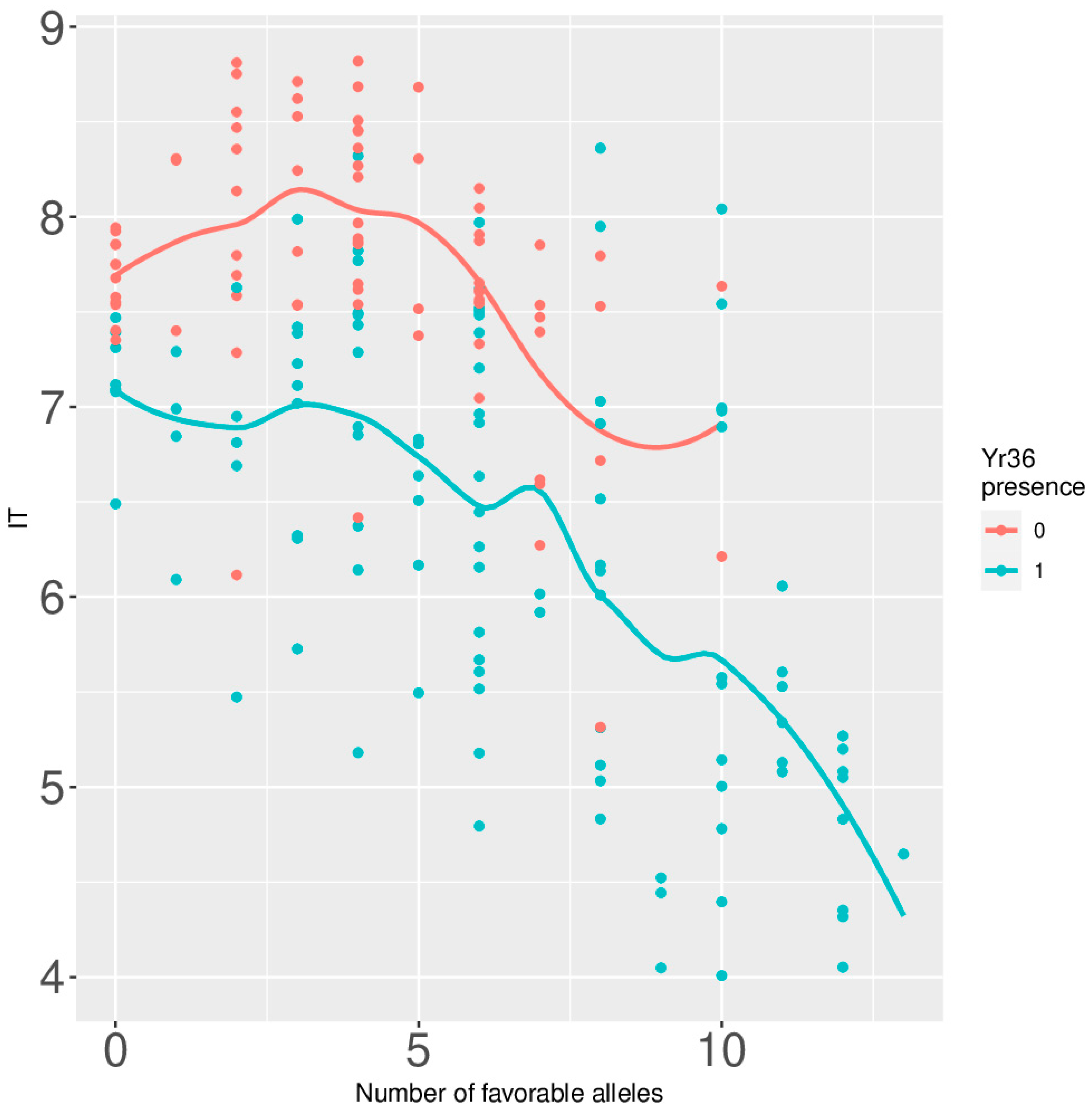
| Field Location | Field Name | 2016 | 2017 | 2018 | Geographical Location DD.DD |
|---|---|---|---|---|---|
| Barkai, ISR | BR | 2 rep | 2 rep | 1 rep | 32.47° N, 35.02° E |
| Zafriyya, ISR | ZA | 1 rep | 2 rep | 1 rep | 32.00° N, 34.84° E |
| Davis, CA, USA | US | 1 rep | 1 rep | 38.53° N, 121.77° W |
| Chr | 40 Mb Window Center Mb | No. of Race/Model Combinations Significant Results | Pst Race List | Models | Max −log10(p) | Max −log10(padj) | Aligned QTL 1 [5] |
|---|---|---|---|---|---|---|---|
| 1B | 80 | 12 | 37, 40, 5006, 14 | Blink, CMLM, FarmCPU, MLMM | 86.83 | 81.52 | Yr15 [20] |
| 1A | 560 | 3 | 5006, 37 | Blink, CMLM, FarmCPU | 30.83 | 25.52 | Q.1A.9 [62] |
| 4B | 640 | 4 | 5006 | Blink, CMLM, FarmCPU | 21.73 | 16.72 | Q.4B.14 [63] |
| 3A | 680 | 3 | 5006 | Blink, CMLM, FarmCPU | 15.25 | 9.94 | |
| 2A | 120 | 6 | 37 | Blink, CMLM, ECMLM, FarmCPU, MLMM, MLM | 9.25 | 4.15 | Q.2A.17 [64] |
| 3A | 720 | 5 | 5006, 37 | Blink, CMLM, ECMLM, MLMM, MLM | 8.44 | 3.43 | |
| 4A | 160 | 3 | 14 | ECMLM, MLMM, MLM | 7.72 | 2.42 | |
| 2B | 160 | 4 | 37 | CMLM, ECMLM, FarmCPU, MLM | 6.68 | 2.26 | Yr31 [65] |
| 1A | 320 | 4 | 37 | Blink, CMLM, ECMLM, MLM | 6.54 | 1.84 | |
| 5B | 120 | 9 | 37 | CMLM, ECMLM, MLM | 6.08 | 1.62 | |
| 1B | 560 | 3 | 37, 5006 | Blink, FarmCPU | 5.79 | 1.47 | Yrv3 [66] |
| Variants | Minimum p-Value of GWAS | GWAS Models | Estimate lmekin | p-Value lmekin | Aligned QTL 1 [5,6] | Putative Genes 2 |
|---|---|---|---|---|---|---|
| 1A_571777232 | 9.20 × 10−9 | mrMLM, FASTmrMLM, pKWmEB | −0.198 | 1.30 × 10−4 | Q.1A.9 15% 3 F 4 [62] | TRIDC1AG060480 WRKY domain [67] |
| 1B_39276972 | 2.15 × 10−10 | mrMLM, FASTmrMLM | 0.390 | 1.10 × 10−12 | MQTL4-1B 15% F [6] | TRIDC1BG006690 Papain-like cysteine peptidase [68] |
| 3B_550434503 | 7.03 × 10−15 | FASTmrMLM, FASTmrEMMA | −0.295 | 6.20 × 10−5 | Q.3B.24 6% F [69] | TRIDC3BG050030 Eukaryotic translation initiation factor 3 subunit eif-3 [70] |
| 3B_707838360 | 9.82 × 10−10 | FarmCPU, MLM, BLINK, mrMLM, FASTmrMLM | −0.221 | 1.80 × 10−3 | TRIDC3BG067020 Peptidase A22B, signal peptide peptidase [71] | |
| 3B_88645297 | 5.40 × 10−5 | ECMLM, MLMM, SUPER | −0.190 | 2.70 × 10−3 | Q.3B.8 6% F [72] Q.B3.9 20% F [73] Q.3B.10 5% F [74] Q3B.12 30% F [75] Q3B.14 5% F [65] | TRIDC3BG015830 alpha/beta hydrolase fold [76] |
| 5B_157144166 | 8.75 × 10−8 | mrMLM, FASTmrMLM, pKWmEB | 0.371 | 2.30 × 10−7 | Q.5B.2 6% F [77] | TRIDC5BG018210 AIG1-type guanine nucleotide-binding [78] |
| 5B_24593659 | 3.12 × 10−10 | mrMLM, FASTmrMLM | −0.337 | 1.30 × 10−8 | Q5B.2 6% F [77] Q5B.3 27% [79] | TRIDC5BG004210 Methyl-CpG DNA binding [80] |
| 5B_527982577 | 2.32 × 10−12 | mrMLM, FASTmrMLM | 0.205 | 2.30 × 10−4 | Q.5B.18 33% [81] Q5B.19 3% F [82] Q5B.20 30% F [83] | TRIDC5BG053620 NAC domain [84] |
| 6B_132922231 | 1.60 × 10−7 | FASTmrEMMA, pKWmEB | −0.221 | 3.30 × 10−3 | Q.6B.3 15% F [62] Q.6B.6 35% F [85] Q.6B.7 6% F [86] | TRIDC6BG018950 NB-ARC [87] |
| 6B_138700000_Yr36 | 3.25 × 10−23 | CMLM, ECMLM, FarmCPU, MLM, MLMM, SUPER, BLINK, mrMLM, FASTmrMLM, pKWmEB, ISIS EM-BLASSO | −0.792 | 7.70 × 10−12 | Yr36 F [9] | kinase_START |
| 6B_664322346 | 4.74 × 10−5 | ECMLM, MLMM, SUPER | −0.206 | 3.90 × 10−4 | Q.6B.16 Q.6B.17 Q.6B.18 [5] | TRIDC6BG064680 WD repeat HIR1 [88] |
| 7A_501622609 | 5.75 × 10−13 | FASTmrMLM, pKWmEB | 0.260 | 5.00 × 10−6 | Q.7A.9 6% F [89] | TRIDC7AG048010 Ubiquitin-Conjugating Enzyme E2 [90] |
| 7B_105138786 | 6.93 × 10−11 | mrMLM, FASTmrEMMA | −0.390 | 5.60 × 10−9 | TRIDC7BG013060 Cellulose Synthase Interactive [91] |
Publisher’s Note: MDPI stays neutral with regard to jurisdictional claims in published maps and institutional affiliations. |
© 2022 by the authors. Licensee MDPI, Basel, Switzerland. This article is an open access article distributed under the terms and conditions of the Creative Commons Attribution (CC BY) license (https://creativecommons.org/licenses/by/4.0/).
Share and Cite
Tene, M.; Adhikari, E.; Cobo, N.; Jordan, K.W.; Matny, O.; del Blanco, I.A.; Roter, J.; Ezrati, S.; Govta, L.; Manisterski, J.; et al. GWAS for Stripe Rust Resistance in Wild Emmer Wheat (Triticum dicoccoides) Population: Obstacles and Solutions. Crops 2022, 2, 42-61. https://doi.org/10.3390/crops2010005
Tene M, Adhikari E, Cobo N, Jordan KW, Matny O, del Blanco IA, Roter J, Ezrati S, Govta L, Manisterski J, et al. GWAS for Stripe Rust Resistance in Wild Emmer Wheat (Triticum dicoccoides) Population: Obstacles and Solutions. Crops. 2022; 2(1):42-61. https://doi.org/10.3390/crops2010005
Chicago/Turabian StyleTene, May, Elina Adhikari, Nicolas Cobo, Katherine W. Jordan, Oadi Matny, Isabel Alicia del Blanco, Jonathan Roter, Smadar Ezrati, Liubov Govta, Jacob Manisterski, and et al. 2022. "GWAS for Stripe Rust Resistance in Wild Emmer Wheat (Triticum dicoccoides) Population: Obstacles and Solutions" Crops 2, no. 1: 42-61. https://doi.org/10.3390/crops2010005
APA StyleTene, M., Adhikari, E., Cobo, N., Jordan, K. W., Matny, O., del Blanco, I. A., Roter, J., Ezrati, S., Govta, L., Manisterski, J., Yehuda, P. B., Chen, X., Steffenson, B., Akhunov, E., & Sela, H. (2022). GWAS for Stripe Rust Resistance in Wild Emmer Wheat (Triticum dicoccoides) Population: Obstacles and Solutions. Crops, 2(1), 42-61. https://doi.org/10.3390/crops2010005







